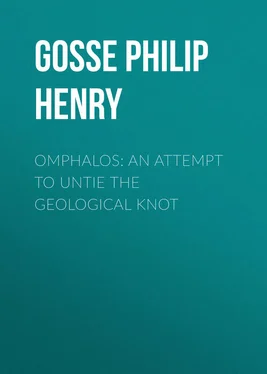Philip Gosse - Omphalos - An Attempt to Untie the Geological Knot
Здесь есть возможность читать онлайн «Philip Gosse - Omphalos - An Attempt to Untie the Geological Knot» — ознакомительный отрывок электронной книги совершенно бесплатно, а после прочтения отрывка купить полную версию. В некоторых случаях можно слушать аудио, скачать через торрент в формате fb2 и присутствует краткое содержание. Жанр: Биология, foreign_antique, foreign_prose, на английском языке. Описание произведения, (предисловие) а так же отзывы посетителей доступны на портале библиотеки ЛибКат.
- Название:Omphalos: An Attempt to Untie the Geological Knot
- Автор:
- Жанр:
- Год:неизвестен
- ISBN:нет данных
- Рейтинг книги:3 / 5. Голосов: 1
-
Избранное:Добавить в избранное
- Отзывы:
-
Ваша оценка:
- 60
- 1
- 2
- 3
- 4
- 5
Omphalos: An Attempt to Untie the Geological Knot: краткое содержание, описание и аннотация
Предлагаем к чтению аннотацию, описание, краткое содержание или предисловие (зависит от того, что написал сам автор книги «Omphalos: An Attempt to Untie the Geological Knot»). Если вы не нашли необходимую информацию о книге — напишите в комментариях, мы постараемся отыскать её.
Omphalos: An Attempt to Untie the Geological Knot — читать онлайн ознакомительный отрывок
Ниже представлен текст книги, разбитый по страницам. Система сохранения места последней прочитанной страницы, позволяет с удобством читать онлайн бесплатно книгу «Omphalos: An Attempt to Untie the Geological Knot», без необходимости каждый раз заново искать на чём Вы остановились. Поставьте закладку, и сможете в любой момент перейти на страницу, на которой закончили чтение.
Интервал:
Закладка:
It was followed by an extensive disruption of the then existing strata, and by changes and modifications so great as to alter the whole face of nature. "It would appear that a long period of time elapsed before newer beds were thrown down, since the chalky mud not only had time to harden into chalk, but the surface of the chalk itself was much rubbed and worn." During this protracted period, eruptions of molten rock occurred of enormous extent, producing the Basaltic formation which covers the Chalk in the north of Ireland, and in some of the Hebrides. In the south of Europe the Pyrenees were elevated, and the Apennines and Carpathians were pushed to a greater altitude than before, if they were not then formed. The Alps and the Caucasus also experienced a series of upward movements, continuing through a considerable range of the Tertiary epoch.
The rich collections of vegetable remains – chiefly fruits and seeds – that have been made from the London Clay, show that the earliest land of this period was clothed with a great abundance and variety of plants; and these are of such alliances as would now require a tropical climate. Many species of Palms, Screw-pines, Gourds, Piperaceæ , Mimoseæ , and other Leguminosæ , Malvaceæ , and Coniferæ , dropped their woody pods and fruits where now these pages are written; and the animals manifest no less interesting an approximation to existing forms than the plants. The Zoophytes, the Echinoderms, the Foraminifera, the Worms, the Crustacea, the Mollusca, the Fishes and the Reptiles of the Eocene beds, exhibit a great preponderance of agreement with those that now exist, so far as genus is concerned , though the species are still almost wholly distinct. The approximation is particularly marked in the Molluscous sub-kingdom, by the almost entire disappearance of the hitherto swarming Brachiopod and Cephalopod forms, and the progressive substitution for them of the Conchifera and Gastropoda , which had, however, throughout the Secondary epoch, been gradually coming forward to their present predominance in nature.
Among the Fishes, the Placoid type was diminished in number; and those that were produced were mostly Sharks and Rays, of modern genera; but the chief difference was the paucity of those mailed forms (Ganoids), which were so abundant during the Oolitic period. On the other hand, the Ctenoid and Cycloid forms, which had begun to make their appearance in small numbers in the Chalk, are well represented. In both this deficiency and this plenitude, there is a very decided approach to existing conditions; for the Ganoids are almost unknown with us, while the last-named two orders are abundant. Representatives of our Perches, Maigres, Mackerels, Blennies, Herrings, and Cods, were numerous; distinct, however, from the present species . But not a single member of the great Salmon family was yet introduced.
The great Saurian Reptiles had entirely disappeared, and were quite unrepresented in the tertiary beds, except by a Crocodile or two, and a small Lizard. Turtles were, however, numerous, both of the marine and lacustrine kinds; and there is an interesting stranger, in the form of a large Serpent, allied to our Pythons, some twenty feet in length.
Birds and Mammals began now to assume their place on the land. The London Clay presents us with a little Vulture; and the Paris basin contains remnants of species representing the Raptores, the Rasores, the Grallatores, and the Natatores.
The Quadrupeds came in in some force; not developed from the lowest to the highest scale of organization; for the Monkey and the Bat occur in sands, certainly not later, if not earlier, than the London Clay, contemporaneously with the Racoon, and before the existence of any Rodent or Cetacean. Some Carnivora, as the Wolf and the Fox, roamed the woods, but the character of the epoch was given by the Pachyderms.
These, however, were not the massive colossi that browse in the African or Indian jungles of our days; no Elephant, no Rhinoceros, no Hippopotamus was as yet formed. But several kinds of Tapir wallowed in the morasses; and a goodly number of largish beasts, whose affinities were with the Pachydermata, while their analogies were with the Ruminantia, served as substitutes for the latter order, which was wholly wanting. These interesting quadrupeds, forming the genus Anoplotherium , were remarkable for two peculiarities, – their feet were two-toed, and their teeth were ranged in a continuous series, without any interval between the incisors and the molars. They varied in size from that of an ass to that of a hare.
The physical conditions of our earth, when it was tenanted by these creatures, is thus described: – "All the great plains of Europe, and the districts through which the principal rivers now run, were then submerged; in all probability, the land chiefly extended in a westerly direction, far out into the Atlantic, possibly trending to the south, and connecting the western shores of England with the volcanic islands off the west coast of Africa. The great mountain chains of Europe, the Pyrenees, the Alps, the Apennines, the mountains of Greece, the mountains of Bohemia, and the Carpathians, existed then only as chains of islands in an open sea. Elevatory movements, having an east and west direction, had, however, already commenced, and were producing important results, laying bare the Wealden district in the south-east of England. The southern and central European district, and parts of western Asia, were the recipients of calcareous deposits (chiefly the skeletons of Foraminifera ), forming the Apennine limestone; while numerous islands were gradually lifted above the sea, and fragments of disturbed and fractured rock were washed upon the neighbouring shallows or coast-lines, forming beds of gravel covering the Chalk. The beds of Nummulites and Miliolites, contemporaneous with those containing the Sheppey plants and the Paris quadrupeds, seem to indicate a deep sea at no great distance from shore, and render it probable that there were frequent alternations of elevation and depression, perhaps the result of disturbances acting in the direction already alluded to.
"The shores of the islands and main land were, however, occasionally low and swampy, rivers bringing down mud in what is now the south-east of England, and the neighbourhood of Brussels, but depositing extensive calcareous beds near Paris. Deep inlets of the sea, estuaries, and the shifting mouths of a river, were also affected by numerous alterations of level not sufficient to destroy, but powerful enough to modify, the animal and vegetable species then existing; and these movements were continued for a long time." 35 35 Ansted's Anc. World, 267.
After the elevation of the mountain summits of Europe above the sea, and while the same causes were still in operation, deposits were being made in the narrow intervening seas of the Archipelago, such as the present south of France, the valleys of the Rhine and Danube, the eastern districts of England and Portugal. These deposits were partly marine and partly lacustrine; the former consisting largely of loose sands, mingled with shells and gravel. In Switzerland is a thick mass of conglomerate; and in the district around Mayence, there is a series of fresh-water limestones, and sandstones charged with organic remains.
The changes which took place during this comparatively recent epoch were not sudden, but gradual; the results of operations which were probably going on without intermission, and perhaps have not yet ceased. The land was more and more upheaved, till at length, what had been an archipelago of islands became a continent, and Europe assumed the form which it bears on our maps.
The most interesting addition to the natural history of the Miocene, or Middle Tertiary period, was the Dinotherium – a huge Pachyderm, twice as large as an elephant, with a tapir-like proboscis, and two great tusks curving downward from the lower jaw. It was, doubtless, aquatic in its habits, and possibly (for its hinder parts are not known), it may have been allied to the Dugong and Manatee, those whale-like Pachyderms, with a broad horizontal tail, instead of posterior limbs.
Читать дальшеИнтервал:
Закладка:
Похожие книги на «Omphalos: An Attempt to Untie the Geological Knot»
Представляем Вашему вниманию похожие книги на «Omphalos: An Attempt to Untie the Geological Knot» списком для выбора. Мы отобрали схожую по названию и смыслу литературу в надежде предоставить читателям больше вариантов отыскать новые, интересные, ещё непрочитанные произведения.
Обсуждение, отзывы о книге «Omphalos: An Attempt to Untie the Geological Knot» и просто собственные мнения читателей. Оставьте ваши комментарии, напишите, что Вы думаете о произведении, его смысле или главных героях. Укажите что конкретно понравилось, а что нет, и почему Вы так считаете.












